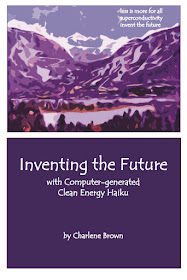Illustration from Inventing the Future
InDesign document
©2019 Charlene Brown
Policy
resolutions, including several regarding or relating to Green Energy were
raised (in some cases ‘fast-tracked’) at the National Convention, held April 8 –
10 on Zoom. Resolutions had originated with various Commissions (Women, Youth, Seniors)
and Provincial branches, and were presented and workshopped on the second day.
Several dozen, including four having to do with green energy, were put forward for
debate and voting on the final day.
There
were over 6000 of us attending the convention and, for each resolution put
forward, everyone had a chance to request debate (four debaters were selected
and debates were conducted only if there were at least 50 requests) and then
vote on whether or not to advance the resolution to the (Election) Platform
Committee. We voted in favour of three of the green energy resolutions,
rejecting the one that stipulated the decommissioning of all nuclear power
generators.
I voted
in favour of the three, despite some misuse of the term ‘renewable’ in two of
them, and was especially impressed with the third because it referred to
alternate (not renewable) energy sources and, in listing them, did not include
biomass. If you read my April 26 blogpost, you’ll know that’s an issue for me.
I’m proud
to have taken part in this policy development process, but suspect that whatever
American President Biden says in the next few weeks will have much more influence on the eventual
Liberal platform. And on the Opposition Platform.














